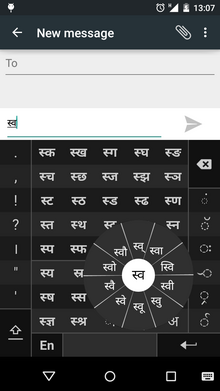Input method

Aninput method(orinput method editor,commonly abbreviatedIME) is anoperating systemcomponent or program that enables users to generate characters not natively available on theirinput devicesby using sequences of characters (or mouse operations) that are available to them. Using an input method is usually necessary for languages that have moregraphemesthan there are keys on the keyboard.
For instance, on the computer, this allows the user ofLatinkeyboardsto inputChinese,Japanese,KoreanandIndiccharacters. On hand-held devices, it enables the user to type on thenumeric keypadto enterLatin alphabet characters(or any other alphabet characters) or touch a screen display to input text. On some operating systems, an input method is also used to define the behavior of thedead keys.
Implementations[edit]

This sectionneeds expansion.You can help byadding to it.(January 2011) |
Although originally coined forCJK(Chinese, Japanese and Korean) computing, the term is now sometimes used generically to refer to a program to support the input of any language. To illustrate, in theX Window System,the facility to allow the input ofLatin characterswithdiacriticsis also called an input method.
OnWindows XPor laterWindows,Input method, or IME, are also calledText Input Processor,which are implemented by theText Services FrameworkAPI.
Relationship between the methodology and implementation[edit]
While the terminput method editorwas originally used forMicrosoft Windows,its use has now gained acceptance in other operating systems[citation needed],especially when it is important to distinguish between thecomputer interfaceand implementation of input methods, or among the input methods themselves, the editing functionality of the program or operating system component providing the input method, and the general support of input methods in an operating system. This term has, for example, gained general acceptance on the Linux operating system; it is also used on the Mac OS.
- The terminput methodgenerally refers to a particular way to use the keyboard to input a particular language, for example theCangjie method,thepinyin method,or the use ofdead keys.
- On the other hand, the terminput method editoron Microsoft products refers to the actual program that allows an input method to be used (for example MS New Pinyin).PRIME[citation needed]orSCIMprefer the term ofInput Method Engine,Input Method platformorInput Method environment,[citation needed]or the actualediting areathat allows the user to do the input. It can also refer to a character palette, which allows any Unicode character to be input individually. One might also interpret IME to refer to the editor used for creating or modifying the data files upon which an input method relies.
See also[edit]
Related techniques[edit]
- Alt codes
- Keyboard layout,in particulardead keys
Input methods versus language[edit]
- Chinese input methods
- Japanese language and computersandJapanese input methods
- Korean language and computers
- Vietnamese language and computers
- Indic scripts input methodsfor languages used in South Asia, Southeast Asia, and parts of Central Asia and East Asia.
Specific input methods[edit]
- List of input methods for Unix platforms
- ATOK,andMS IME for Windows
- Tise—Tibetan IM for Windows
- Wnn
Input methods for handheld devices[edit]
- Multi-tap—Used on many mobile telephones—hit the (combined alphanumeric) key for the letter you want until it comes up, then wait or proceed with a different key.
- T9/XT9—Type the key for every letter once, then, if needed, type Next until the right word comes up. May also correct misspellings and regional typos (if an adjacent key is pressed incorrectly).
- iTap—Similar to first-generation T9, with wordautocomplete.
- LetterWise—Hit the key with the letter you want, if it doesn't come up, hit Next until it does.
- FITALYAn array, almost square, which minimizes distance traveled from one letter to another.
- MessagEase,an input method optimized for the most common letters, that can enter hundreds of characters with single hand motions
- 8pen,an input method using circular swipes in an attempt to mimic hand movements
- Graffiti,the Palm OS input method, entered using a stylus
- Pouces,an input method using touches and swipes
Virtual keyboards[edit]
- Fleksy—Eyes-free touch typing for touchscreen devices, also used by blind / visually impaired people.[1]
- SwiftKey—context-sensitive word-prediction[2][3]
- Swype,an input method that uses swiping gestures instead of tapping to quickly enter text
- Gboard,the keyboard that comes bundled with the Android operating system
References[edit]
- ^Meddaugh, Jason (2013-02-01),2012: A Technology Year in Review,US: American Foundation for the Blind, archived fromthe originalon 2021-02-11,retrieved2013-02-25,
Our top story of 2012 involves a formerly little-known app called Fleksy and its rise toward prominence and mainstream acceptance.
- ^Fiedlerová, Klára (2012-05-10),Possibilities of Text Input for Handicapped People(PDF),Prague: Czech Technical University in Prague, p. 15, archived fromthe original(PDF)on 2017-10-14,retrieved2012-08-01,
Word prediction is used to speed up the text entry. The prediction system uses the context of the sentence to predict three words that could be used next.
- ^ "For phones - SwiftKey".SwiftKey.TouchType.Retrieved2016-10-21.
External links[edit]
- Microsoft Input Method Editors (IMEs) for Chinese, Japanese and Korean
- BhashaIndia,the Microsoft portal for Indic languages, which has Indic IME for download.
- Google Transliteration IMEs
